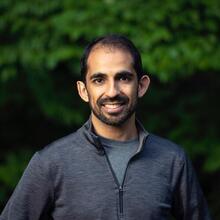
How to meditate and become more mindful
Kunal Gupta (BSE '08) offers guided mindfulness practices for fellow alumni

Kunal Gupta (BSE '08) offers guided mindfulness practices for fellow alumni
By Dana Ciak Office of AdvancementIn our recent webinar series, Waterloo alumni share their passions and expertise to support others during this strange time.
 Kunal Gupta (BSE ’08) is the CEO of Polar, a digital media technology provider for the world’s largest publishers and agencies. Kunal is also a mindfulness practitioner, volunteer with several mental health organizations, meditation and yoga teacher and author on topics of leadership, mindfulness and technology culture on his blog Reflections by Kunal Gupta.
Kunal Gupta (BSE ’08) is the CEO of Polar, a digital media technology provider for the world’s largest publishers and agencies. Kunal is also a mindfulness practitioner, volunteer with several mental health organizations, meditation and yoga teacher and author on topics of leadership, mindfulness and technology culture on his blog Reflections by Kunal Gupta.
Kunal began using mediation as a tool for his personal self-awareness and shares some useful tips to help you practice mindfulness that are simple yet powerful, especially in the midst of a global health pandemic and economic recession. Read on for three tips from Kunal to help your meditation practice, and instructions for a writing exercise that he uses daily. To join in a guided meditation with Kunal, watch the full webinar below.
During any mindfulness practice, resist the urge to stop or control your thoughts. Our minds are naturally full of thoughts, they are like breathing and are part of the process of living.
Meditation is the practice of accepting whatever it is you start to become aware of during your mindfulness practice. Awareness is a skill you should apply to everything. It is like learning to live with the lights on in your subconscious. Mediation is about thinking, and being aware of that thinking, and allowing the thoughts to flow.
Alertness is about the posture you keep specifically during mediations. Avoid using back support. Not having back support encourages the spine to remain more alert which also keeps the mind more alert. You don’t want to be falling asleep during meditation.
KUNAL GUPTA, Entrepreneur and mindfulness expert
Meditation opened a door inside of me and I entered this world that I didn’t know existed, my inner world, and it was building an intimate relationship with myself. It is a fascinating journey and one where I keep discovering values and beliefs.
Using a pen and a piece of paper, allow yourself to start writing whatever comes into your head and do not allow yourself to stop, no matter how meaningless your writing may seem. Keep your pen moving on the piece of paper during the whole practice (about five minutes).
Do not give yourself a moment to construct formal thoughts with your pen off the paper, just keep writing.
After five minutes of continuous writing, stop and do not look at the paper. Discard of it. Now close your eyes and notice any emotions you may be feeling after the session.
Be aware and accept how you are feeling.

Read more
Here are the people and events behind some of this year’s most compelling Waterloo stories

Read more
More than 20 founders from Waterloo highlight the newly unveiled list that celebrates those making the biggest impact inside Canadian tech and innovation

Read more
The Kitchener-Waterloo Oktoberfest Rogers Women of the Year awards recognize leaders for outstanding community contributions
The University of Waterloo acknowledges that much of our work takes place on the traditional territory of the Neutral, Anishinaabeg, and Haudenosaunee peoples. Our main campus is situated on the Haldimand Tract, the land granted to the Six Nations that includes six miles on each side of the Grand River. Our active work toward reconciliation takes place across our campuses through research, learning, teaching, and community building, and is co-ordinated within the Office of Indigenous Relations.